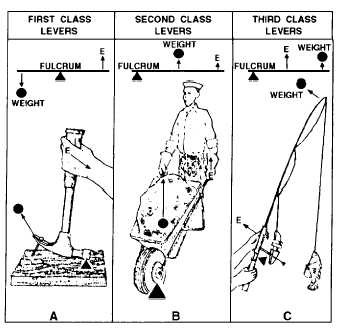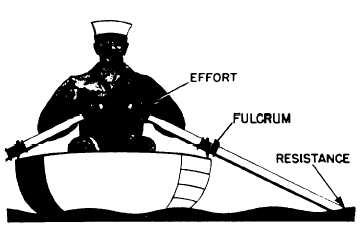Figure 1-1.-A simple lever.
operation of complex machines. Complex machines are
merely combinations of two or more simple machines.
THE LEVER
The simplest machine, and perhaps the one with
which you are most familiar, is the lever. A seesaw is a
familiar example of a lever in which one weight
balances the other.
You will find that all levers have three basic parts:
the fulcrum (F), a force or effort (E), and a resistance
(R). Look at the lever in figure 1-1. You see the pivotal
point (fulcrum) (F); the effort (E), which is applied at a
distance (A) from the fulcrum; and a resistance (R),
which acts at a distance (a) from the fulcrum. Distances
A and a are the arms of the lever.
CLASSES OF LEVERS
The three classes of levers are shown in figure 1-2.
The location of the fulcrum (the fixed or pivot point) in
relation to the resistance (or weight) and the effort
determines the lever class.
First Class
In the first class (fig. 1-2, part A), the fulcrum is
located between the effort and the resistance. As
mentioned earlier, the seesaw is a good example of a
first-class lever. The amount of weight and the distance
from the fulcrum can be varied to suit the need.
Notice that the sailor in figure 1-3 applies effort on
the handles of the oars. An oar is another good example.
The oarlock is the fulcrum, and the water is the
resistance. In this case, as in figure 1-1, the force is
applied on one side of the fulcrum and the resistance to
be overcome is applied to the opposite side; hence, this
is a first class lever. Crowbars, shears, and pliers are
common examples of this class of levers.
Second Class
The second class of lever (fig. 1-2, part B) has the
fulcrum at one end, the effort applied at the other end,
and the resistance somewhere between those points. The
Figure 1-2.-Three classes of levers.
Figure 1-3.-Oars are levers.
wheelbarrow in figure 1-4 is a good example of a
second-class lever. If you apply 50 pounds of effort to
the handles of a wheelbarrow 4 feet from the fulcrum
(wheel), you can lift 200 pounds of weight 1 foot from
the fulcrum. If the load were placed farther away from
the wheel, would it be easier or harder to lift?
Levers of the first and second class are commonly
used to help in overcoming big resistances with a
relatively small effort.
Third Class
Sometimes you will want to speed up the movement
of the resistance even though you have to use a large
amount of effort. Levers that help you accomplish this
are in the third class of levers. As shown in figure 1-2,
part C, the fulcrum is at one end of the lever, and the
1-2





